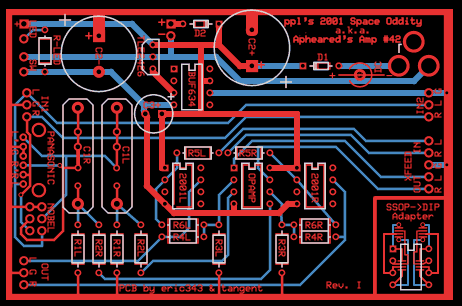puppyslugg
Headphoneus Supremus
- Joined
- Jan 31, 2002
- Posts
- 1,642
- Likes
- 10
***


| Originally posted by eric343 Merton- Yes. Jeffrey - what might also be contributing to the ringing/overshoot is that I'm running it into a 1M scope probe as a load- not the <50ohms that the EL2009 requires to be run into if you don't want to use a snubber. So I think I may need to use a snubber... 
(incidentally, do snubbers go inside or outside the feedback loop?) |

| Originally posted by ppl ... it is possible to get no ringing a good phase margin and stable operation if the Active Devices are properly chosen and the layout is done with attention to Critical Nodes with additional attention paid to The placement and the souroundings of the gain stages Inverting (-) Input. for simplicity sake Op Amp = gain stage as treated hear. |



| Originally posted by ppl In Eric's case He is still learning and is incredibly sharp in comprehention and can understand things very well. I think that elimitating the ringing from his Amp under discussion hear will pay big rewards later on since he will then reconise the symtom and will have formed a method of attacking the issue should it come up again later. IMHO people like Eric should be encouraged to persue perfection and not settle for the Easy answer but futher refine there technique. |



| Originally posted by ppl jeffreyj> Yes I admit that my prototyping is more involved than what is normaly considered reasonable. |
| I feel rather silly redirecting your attention to the title of this site. |
We are far from attaining this goal ,but the knowledge that is required is not complete in the text books of our time. So I would put to you this question....When and where will this new defenition of Hi fidelity arise.
|

| Originally posted by jeffreyj So let me get this straight: you state that ringing results in "grain and harshness," so, presumably, my "textbook advice" which eliminated it would be right and proper in the overall aim of achieving high fidelity. But then you imply that it is not compatible with high-fidelity in the above quote. So which is it, ppl? |
| So you are single-handedly extending the state of the art beyond what is in "text books of our time", eh? Uh-huh. Right. |

| You, for example, are more of an authority on analog circuit design than Bob Pease, then? Can out do Douglas Self when it comes to designing amplifiers? Move over Horowitz and Hill, ppl's got a new Art of Electronics he'd like to share with the world? |



| Yeah, right. A lot of the people here won't know any better when they see, for example, the multiple current sources feeding the power-on LED in the PPA. I recognize it for what it truly is, ppl: needless complexity in the hopes of making a unique circuit, not necessarily a better sounding one. |
| I'd love to see ppl write a book on electronics |

| Originally posted by eric343 The problem here is that textbooks ain't everything... some things come from experience. Keep in mind that textbooks are written with the goal of teaching electronics, not how to design high fidelity audio circuits... It's a common trap; having learned a whole bunch of stuff from one source, you then treat it as the be-all end-all Spring of Knowledge against whose authority none may go without incurring your wrath. Except they AIN'T the Spring of Knowledge, and there's stuff to know that ISN'T in them. |
| Originally posted by jeffreyj We weren't discussing what method of prototyping was best for you, ppl, we were discussing what method was best for Eric. I think it is questionable, at the very least, to advise a "beginner" in any endeavor to discount the acquired wisdom of all who came before and instead re-invent the wheel as many times as is necessary to "get it right." Your advice to Eric to ditch the shunt capacitors was impractical and I called you on it. So let me get this straight: you state that ringing results in "grain and harshness," so, presumably, my "textbook advice" which eliminated it would be right and proper in the overall aim of achieving high fidelity. But then you imply that it is not compatible with high-fidelity in the above quote. So which is it, ppl? So you are single-handedly extending the state of the art beyond what is in "text books of our time", eh? Uh-huh. Right. You, for example, are more of an authority on analog circuit design than Bob Pease, then? Can out do Douglas Self when it comes to designing amplifiers? Move over Horowitz and Hill, ppl's got a new Art of Electronics he'd like to share with the world? Yeah, right. A lot of the people here won't know any better when they see, for example, the multiple current sources feeding the power-on LED in the PPA. I recognize it for what it truly is, ppl: needless complexity in the hopes of making a unique circuit, not necessarily a better sounding one. Regards The Objective One |


